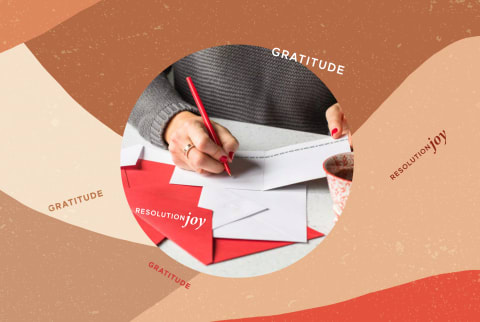Make Gratitude Actionable: 15 Ways To Show Appreciation For Others


In 2021, we're focusing on joy. After the year we've had, cultivating and celebrating small moments of happiness as they come has never felt more cathartic, life-affirming, and essential to lasting well-being. In the coming weeks, we're going to laugh, experience new things, and revamp stale aspects of daily life. Come back each day for a new "Resolution Joy" installment, where you'll find inspiration and expert-backed advice, free classes, and—dare we say?—fun activities.
When we strive to practice gratitude, it's often viewed from an internal lens. Whether it's through journaling or meditation, these feelings of appreciation have been shown to boost overall well-being1 and may even relieve stress2. While self-expressions of gratitude are essential, extending that gratitude to others can also go a long way.
A study published in the American Journal of Public Health says helping others not only makes you feel good, but it may also reduce mortality by lowering stress3.
With nearly a year of isolation behind us and a continued call for social distancing in 2021, finding ways to show support for others remains critical. This year, as a way to cultivate joy in your own life and the lives of those around you, turn your gratitude into action. Here are a few ways you can start:
Write letters.
Growing up, many people were taught to write thank-you letters after receiving birthday or holiday gifts. Sending a letter of appreciation doesn't have to be confined to such specific moments, though.
Think about the times you've received an unexpected piece of snail mail. You probably felt special and acknowledged, right? Well, allow someone else to experience that feeling, too.
Start by spending a few minutes reflecting on people you feel especially grateful for—your mom, your best friend, your partner, or your mail carrier—whoever comes to mind. Then, spend a few more minutes reflecting on the ways in which they've provided you support or made a difference in your life. Finally, express those thoughts in the letter.
Research shows writing affectionate letters can actually lower cholesterol, making the benefits of this practice threefold. On the one hand, you're cultivating gratitude. On the other, you're making someone feel loved. And finally, you're supporting your heart health. If you need more guidance, here is a step-by-step guide for writing a love letter.
Learn someone's love language and respond to it.
You may be tempted to give someone a hug when you're feeling appreciative of them, or perhaps you buy them a gift to say thank you. While neither of these responses is wrong, they may not be the most impactful. Instead, learn someone's love language so you can express gratitude in a way that's meaningful to them.
According to research from Gary Chapman, Ph.D., one of the most common love languages is words of affirmation. For those people, verbally expressing your gratitude by saying "thank you. You mean a lot to me. I feel so loved by you," etc., will likely mean more than a gift would. For others, whose love language is quality time, planning a day together would be a special way to say "thanks for all you do."
Give someone a bear hug.
As mentioned before, not everyone is a fan of physical touch, so know your audience. If the person is receptive to it, though, embracing in a bear hug can bring you both joy.
According to intimacy expert Julian Colker, the bear hug helps activate the parasympathetic nervous system, making someone feel less stressed.
"This type of hug is so satiating on a physical, human level," relationship and intimacy consultant Marla Mattenson previously told mbg.
Engaging in this type of physical and emotional closeness is a subtle way to express your gratitude without actually saying thanks.
Practice active listening.
Active listening is the process of creating space for another person to talk and fully engaging in what they have to say. "Rather than internally rehearsing what they might say next or drifting into judgment, the listener is completely attentive," licensed marriage and family therapist Tiana Leeds, M.A., LMFT, tells mbg.
What does listening have to do with gratitude? Well, by creating an environment for someone to feel safe enough to speak, and trust that they're being heard, you're showing them you care. You're showing them that you appreciate who they are and what they have to say.
Other ways to show gratitude:
- Leave a sticky note on your roommate's bathroom mirror saying one thing you love about them.
- Leave your waiter or food delivery driver a bigger tip than you normally would.
- Be patient with others, even when you're feeling rushed.
- Offer to run an errand for someone when they seem overwhelmed (if they're an acts of service person, surprise them by getting the task done without asking).
- Bring someone flowers.
- In your next meeting, shout out a co-worker who made your life easier that week.
- Invite someone to tag along (even virtually) to your workout class, poetry reading, or other event they may like.
- Smile at someone.
- Cook someone a meal or deliver them baked goods.
- Give someone a compliment.
- Mail someone a book that reminded you of them.
Bottom line.
There are several benefits of gratitude, both in terms of physical and mental health. After a year of social isolation, political turmoil, disease, grief, and challenges, cultivating joy can seem difficult. Showing gratitude for others is just one way you can reconnect to that joy.

Abby Moore is an editorial operations manager at mindbodygreen. She earned a B.A. in Journalism from The University of Texas at Austin and has previously written for Tribeza magazine. She has covered topics ranging from regenerative agriculture to celebrity entrepreneurship. Moore worked on the copywriting and marketing team at Siete Family Foods before moving to New York.